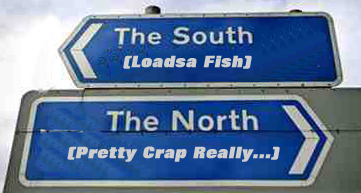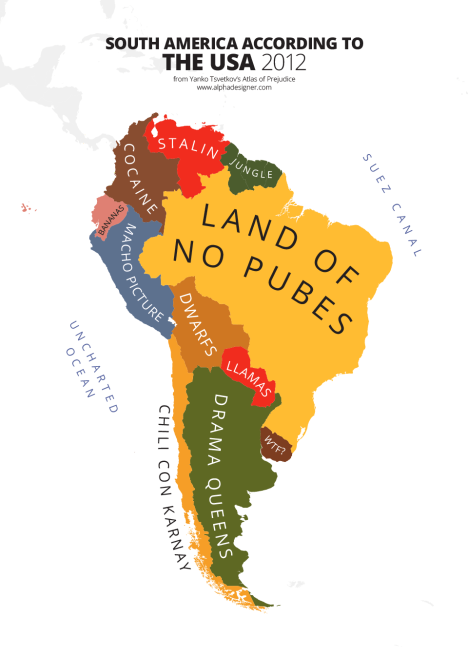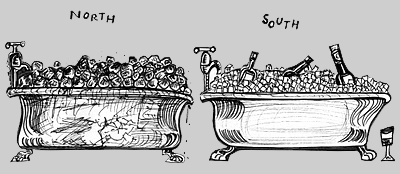I had Ron Clay on the phone this week. Aparently there’s an article in the current issue of Coarse Angler Today arguing there is no north/south divide in angling. Now I don’t normally comment on things I’ve not read and I haven’t a clue who has written the piece either, but here’s my take on the matter.
This is the official list of record fish caught in the British Isles and published by the BRFC:
Coarse Fish Records © British Record (Rod Caught) Fish Committee 2013
BARBEL (Barbus barbus) 21-1-0: 2006: Grahame King: Adams Mill Fishery, Bedford.
BITTERLING (Rhodeus sericeus) 0-0-12: 1998: Dennis Flack: Barway Lake, Cambs.
BLEAK (Alburnus alburnus) 0-4-9: 1998: Dennis Flack: River Lark, Cambs
BREAM (Common Bronze) 22-11-0: 2012: Scot Crook: Ferry Lagoon, Cambs.
BREAM (Silver) 3-4-0: 2012: Gareth Evans: Mill Farm Fishery, Pullborough, Sussex
BULLHEAD (Cottus gobio) 0-1-0: 1983: R Johnson, Green River, Nr Guildford, Surrey
CARP (Mirror) 67-8-0: 2008: Austin Holness, Conningbrook Lake, Ashford, Kent.
CARP (Crucian) 4-9-0: 2003: Martin Bowler, RMC Fishery, Yateley Lake, Hampshire.
……………………………….2004: Phil Smith, RMC Fishery, Yateley Lake, Hampshire.
……………………………….2011: Joshua Blavins, Stillwater, Hertfordshire.
CARP (Grass) 44-8-0: 2006: Phillip Kingsbury, Horton Church Lake.
CATFISH (Bullhead, black) 1-3-0: 2001: K Clements, Lake Meadows, Billericay, Essex
CATFISH (Wels) 62-0-0: R Garner, Withy Pool, Henlow, Bedfordshire
CHUB (Leuciscus cephalus) 9-5-0: Andy Maker, Southern Stillwater.
DACE (Leuciscus leuciscus) 1-5-2: Simon Ashton, River Wear, Tyne & Wear.
EEL (Anguilla anguilla) 11-2-0: 1978: Master S Terry,Kingfisher Lake, Hampshire.
GOLDFISH (Brown) 5-11-8: 1994: Six Acre Still Water Pond, Surrey.
GUDGEON (Gobio gobio) 0-5-0: 1990: D H Hull, River Nadder, Wiltshire.
MINNOW (Phoxinus phoxinus) 0-0-13.5: 1998: J Sawyer, Whitworth Lake, Spennymoor
ORFE (Golden) 8-5-0: 2000: Michael Wilkinson, Lymm Vale, Cheshire
PERCH (Perca fluviatilis) 6-3-0: Neil Stephen, Stream Valley Lakes, Sussex.
…………………………………..6-3-0: Ken Brown, Willstone Fishery, Tring, Hertfordshire.
PIKE (Esox lucius) 46-13-0: 1992: R Lewis, Llandegfedd, Wales.
PUMPKINSEED 0-14-2: 2003: Bryan Rushmer, Tanyards Fishery, Sussex.
ROACH (Rutilus rutilus) 4-4-0: 2006: Keith Berry, Stillwater, Northern Ireland.
RUDD 4-10-0: 2001: Simon Parry, Freshwater Lake, Co Armagh, N.Ireland.
………..4-10-0: 2001: Simon Parry, Clay Lake, Co Armagh, N.Ireland
RUFFE (Gymnocephalus cernuus) 0-5-4: 1980: R J Jenkins, West View Farm, Cumbria
SCHELLY 2-1-9: 1986 S M Barrie, Haweswater Reservoir, Cumbria
STICKLEBACK (3-spined) 0-0-4: 1998: Dennis Flack, High Flyer Lake, Ely, Cambs.
STONE LOACH 0.013gr: 2005: Geoffrey Green, Windmill Fishery, Bristol, Avon.
TENCH (Tinca tinca) 15-3-6: 2001: D Ward, Private Fishery, Staines, Surrey.
WALLEYE (Pikeperch) 11-12-0: 1934: F Adams, The Delph, Welney, Norfolk.
ZANDER 21-5-0: 2007:James Benfield, R Severn, Tewksbury, Glos.
Now I do appreciate that folk who live in Kent think that Essex is north but I regard Cumbria, Northumberland, Durham, Lancashire, Yorkshire, Cheshire, Nottinghamshire and parts of Lincolnshire as north. South of those counties we might be splitting hairs over what constitutes the midlands but this is a straight north/south debate.
In South America it’s a lot easier:
But let’s not get distracted. In total the north can only lay claim to the schelly, ruffe, minnow, dace and golden orfe records. Yes, a pedant might say that record rudd and roach were caught in Northern Ireland but that might as well be in Holland because it’s not like you can get there without crossing a sea. Neither the biggest roach or rudd caught in mainland Britain came from the north, did they?
Of the five records currently held by the north we can discount the orfe. It’s a non-native species, the fish in question was a one-off and it died nearly 15 years ago.
Now seriously, who is going to target schelly? It is a member of the salmon family, supposedly exists in a very limited number of deep waters in the Lake District and to top that off it is now a protected species so you are no longer allowed to fish for them anyway. Oh, and that record was established 27 years ago.
So now we’re down to 3 starget species and what great targets they make.
Well, we cannot deny that Cumbria is our jewel in the crown having produced a record ruffe 33 years ago and also produced a record minnow (25 years ago). A fish weighing less than an ounce. I can see those poncey Southerners loading up their off-roaders right now! Let’s head north and show them wankers how it’s done.
This leaves us with Simon Ashton’s dace, a fish caught 11 years ago from the Wear. Unfortunately the Wear has been decimated by cormorants and no longer produces the dace runs it was once famous for. Those specimens simple don’t exist today.
So there we have it. Facts don’t lie. Any southern angler who thinks that fishing in the North is fabulous should come and prove it. Show us how it’s done. They will quickly learn that we have more big cat sightings than big crucians. Rudd waters? Don’t make me laugh. Yorkshire anglers who have caught a genuine 7lb tench from their home county are still in a tiny, tiny minority.
Lets be honest. Brutal even. Anyone who thinks specialist angling is a level playing field is either a looney, being deliberately provocative or is taking the piss. What I do appreciate is whenever these brilliant specialist anglers from the south have made a rare venture up to the Trent most have been found woefully lacking. As for the Yorkshire rivers I doubt they are even aware they exist.
No offense lads and lasses. Enjoy your dream fishing while it lasts but don’t try and tell us northern monkeys that we’ve never had it so good. That’s bollocks!
Footnote: It’s not all bad up north according to this link – the beer’s cheaper!




The record list is certainly misleading. Several fish should be on the list but aren’t and conversely some fish on the list shouldn’t be there. The biggest dace for instance came from the Hants Avon (the old record that was never investigated at all when dropped in 1968) and Dorset Frome, the biggest roach from Essex, biggest rudd from Norfolk, biggest grayling from the Test. Some waters skew things badly – Mill Farm for silver bream, Marsh Farm for crucians, so that whether such potential could be realised elsewhere is unclear – though my hunch is that the best crucian potential is some unknown home counties gravel pit. Hard to know where the south ends and the north begins as well – I live so far south in England that Calais is actually NORTH of me.
Currently the most productive big roach water seems to be in Scotland not that there aren’t still a few big ones in the Dorset/Hants rivers and elsewhere. The Fens seem to be the place for rudd. The rivers with the greatest untapped potential are the Trent and Thames, both rivers having fish beyond most anglers’ dreams of a number of species yet plenty of largely ignored water. Even waters in the doldrums seem to bounce back when you least expect it as I’m finding with one or two of my local waters. Other waters, especially rivers, seem to have fallen into disuse as far as angling is concerned – I’m going to fish a bit of water on Monday that I first fished 40 years ago and that I think hardly gets fished at all now; it doesn’t open until September and looks like it has some fish so should be interesting yet when I’ve fished the next stretch down I’ve rarely seen anyone on that bit, certainly not the last three years. In the end as long as you enjoy your fishing what does it matter because like money you can’t take it with you!
Can’t disagree with most of what you say Mark although I certainly don’t regard the Trent as having untapped potential. Feel free to explain what you actually mean by the Trent’s untapped potential.
There are more anglers fishing the Trent round the clock (with multiple rods on bolt rigs) than any other in the UK and whenever a big fish is landed it tends to be a repeat capture rather than a new fish. Collingham’s hyped and inflated reputation was built on just 4 recognisable fish. Mostly it’s a runs water throwing up plenty of shoal fish with a few low doubles thrown in.
I fished a prolific area last year and caught nearly 100 barbel in two day sessions. Only one fish was a genuine double. Of course, Facebook and the like is full of folk wanting to brag (and frequently exaggerate) about the big Trent fish they catch. What it doesn’t tell us is how often those anglers blank or how rare those 12’s and 13’s are. A 14 is still a huge fish from the Trent. Rare even. Anything above that is truly exceptional.
The Trent has producing quite a few (low) 6lb chub in recent seasons, though not from everywhere and they’re thinner on the ground than you might have been led to believe, and the occasional very, very, rare seven. It is certainly not going to threaten the Lee or the Thames, Ouse, nor the Hants Avon/ Dorset Stour any time soon.
It’s funny that not one of the usual suspects who have joined the gold rush to fish Lochnaw has done tests on the authenticity of the fish. Everyone knows the water holds rudd as well as roach and some of the fish I’ve seen look to have a little tar brush in them. A good friend of mine who has caught more than his share of 2’s and the odd three here in England admitted that he had his doubts over some of the fish he caught from there. Then again, are we talking north versus south in England or the British Isles because it suits in this instance?
As for rivers bouncing back, I’ve spent my whole life waiting for the Yorkshire Rivers to bounce back but unfortunately I’m no longer sure we’d recognise what it is they will bounce back into being!
Fenland is indeed a bit of a rudd mecca right now. But as it’s a good 2-hour drive south from south yorkshire I cannot consider it to be a northern venue. If you consider that I live 155 miles south of the Scottish border at Berwick then it would be something of a stretch to suggest any water that’s a 2-hours drive south of here could possibly be classed as northern.
You may live south of Calais Mark, but just think on. I live in SOUTH Yorkshire yet this is still NORTH of Berlin, Amsterdam, Krakow and Tiblisi – so ner! 😉
Other than the Scottish Lochnaw, 2 lb roach are very difficult to find north of the Trent. All the 2 lb roach I ever caught save one, came from southern gravel pits.
The Nottinghamshire River Idle years ago had a reputation for 2 lb roach, but in reality the scales usually stopped at 1lbs 14 oz. My biggest from the Idle went 1lb 15 oz, taken from a stretch near Lound, just north of Retford.
Many fine anglers who spent lifetimes after 2 lb Idle roach never caught one and here I include Tag Barnes, John Neville and John Ledger.
I have found a medium sized sand and gravel pit just north of Lincoln with genuine 2 lb roach in it. I intend to try and catch one this autumn and winter.
But I am going to need a little luck.
We must not forget the dace of the River Ryton, a tributary of the river Idle. I fished this little river from a child, living about an hours bike ride from my home near Letwell.
For a short period, 1958 to 1962 I would guess, the Ryton threw up some of the biggest dace in the country. I had a fish of 1 1/4 lbs and Tag Barnes, on one occasion, had 6 all over 12 oz. He lost a monster on once when a gale took the rod out of his hands.
But we kept quiet about the Ryton, on Tag’s advice.
These days the Ryton still has roach dace and chub, but nothing like the fish that existed in the late 50s and early 60s when a handful of Northern Specimen Hunters Group members frequented its banks.
Hi Ron,
I think you need to revisit the Ryton as it’s not remotely like the river you knew 50 years ago. The natural river of old is now a shallow trapezoidal drainage channel.
I reckon you would have an interesting challenge on your hands if you tried to catch an 8oz roach from there between now and the end of the season…
Pingback: September Fishing Blog ...Already!!! » Lee Swords Fishing - Lee Swords Fishing -
Do you know I recently went down to Berkshire and paid over 4 quid for a pint of Guinness.
In the pub across the roads it’s £2-65
Nice post Bob!
What I wanted to gain from that editorial was some insights into why some anglers apparently do not appreciate the fact they can only catch what is in front of them, and therefore should judge each individual capture with the merit it deserves. I never intimated nor suggested that Northern anglers have never had it so better, just that Southern anglers don’t appreciate meritorious captures due to being numb to all these monsters down here. However, you are right in that I was almost being deliberately provocative and indeed have been known to take the piss on the odd occasion. Hooray! Go me! Anyhow, keep up the awesome work, I really enjoy reading your features and watching your videos. If you ever fancy some dead easy southern specimen angling, let me know and I can take you to my pre-baited Thames spots.
All the best and tight lines,
Sam Meeuwissen
Cheers Sam. I’ll do my best to keep up the good work. Indeed I’m hoping normal service will be resumed shortly when the house move is completed.
Recently I acquired a copy of a book I have been after for some time. It is “Carp and the Carp Angler” published in 1980 and written by Sheffield Carp angler – George Sharman. I recently was able to contact George where we discussed many aspects of angling, including the relative size of fish and how they vary in size from the north to the south of England
In his book, George, writing on this subject, says the following:
“I now look upon the size or number of carp I catch in relative terms. A 10 lb carp is big where the average size is 6 or 7 lbs and a 16 pounder is only average in a water which contains a fair head of 20s. That one man is destined to fish the first water while another is privileged to fish the second has no bearing on the angling abilities of either. Only when the two anglers fish the same water for a season could any sensible comparison be made………..if it had to be,”
Wise words from a great angler who, well into his 80s, still fishes all-night sessions
Bob
I have a cased Dace in my office 12-3/4 ounce caught in the River Hull in 1935 that must have been a good fish those days for a northern water